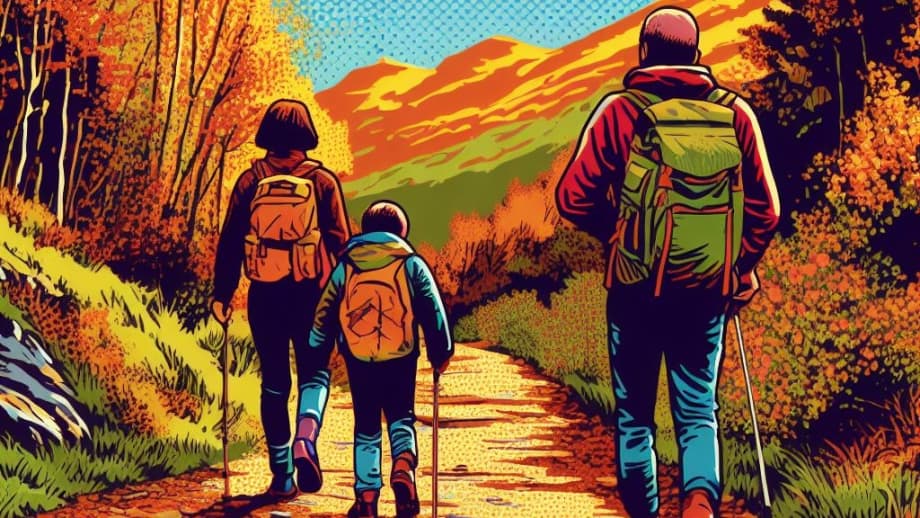Hiking is an adventure that connects us with the beauty of nature, but it often comes with an unwelcome companion—blisters. The joy of reaching new summits and exploring serene trails can quickly be overshadowed by the discomfort these small yet mighty adversaries bring.
I used to get blisters nearly every time I hiked. It got to the point where I thought getting blisters was just a part of hiking. But then, I started talking to other hikers, learned how to take better care of my feet, and found the right shoes for hiking. Now, I hardly ever get blisters. And if I do, I know how to take care of them quickly so they don’t ruin my hike.
In this post, we’ll share some great tips and tricks that really helped my feet and made me love hiking even more. We’ll talk about how to pick the right hiking gear and what you can do before you even start your hike to keep your feet happy and free from blisters.
Key Takeaways
- Understand Blisters: Recognize that blisters are caused by friction, moisture, and heat, leading to the separation of skin layers and fluid buildup.
- Proper Footwear is Crucial: Invest in well-fitting hiking boots or shoes made from breathable materials to reduce the risk of blisters.
- Socks Play a Key Role: Choose the right socks, preferably made of moisture-wicking materials like Merino wool or specific synthetic blends, to keep feet dry and reduce friction.
- Pre-Hike Foot Care: Prepare your feet by starting with clean, dry skin, trimming your toenails, and considering the use of foot balm or tape on sensitive areas to prevent blisters.
- Manage Moisture: Keep your feet dry by choosing breathable footwear, changing socks during long hikes, using foot powder, and avoiding wet conditions when possible.
Recommended Anti-Blister Products

Body Glide Foot Glide Anti Blister Balm | blister prevention for heels, shoes, cleats, boots, socks, and sandals | Use on toes, heel, ankle, arch, sole and ball of foot | 0.8oz

Nexcare Blister Prevention Tape, Waterproof Foam Medical Tape, Sticks Firmly to Skin to Help Prevent Blisters - 1 In x 5 Yds, 1 Roll of Tape
Blister Prevention Tips & Techniques
- Break in New Hiking Shoes: Wear your new hiking boots or shoes around the house and on short walks before embarking on longer hikes to ensure they mold to your feet and reduce the risk of blisters.
- Double Layer Your Socks: Wear a thin liner sock under a thicker hiking sock. This technique allows the socks to rub against each other, rather than your skin, reducing friction.
- Use Anti-Blister Products: Apply anti-blister sticks, balms, or powders to high-friction areas like heels, toes, and the sides of your feet before putting on your socks.
- Keep Feet Dry: Use moisture-wicking socks and breathable shoes to keep your feet dry. Consider carrying an extra pair of socks to change into during your hike.
- Lace Your Shoes Properly: Use lacing techniques that secure your foot within the shoe to prevent sliding, which can increase friction and cause blisters.
- Hydrate: Staying hydrated helps maintain your skin’s elasticity, making it less prone to blistering.
- Avoid Cotton Socks: Cotton retains moisture, which can soften the skin and increase the likelihood of blisters. Opt for wool or synthetic materials instead.
- Foot Pads and Tape: Before hiking, apply padded tape or special blister pads to known trouble spots as a preventive measure.
- Check Your Fit: Make sure your hiking shoes fit properly, with enough room to wiggle your toes but not so loose that your foot slides around.
- Condition Your Feet: Gradually increase hiking distances to condition your feet and skin to the rigors of hiking.
- Keep Nails Trimmed: Long toenails can cause pressure and friction inside your shoes, leading to blisters. Keep them short and smooth.
- Rest and Inspect Your Feet: On longer hikes, take breaks to rest and check your feet for early signs of blisters, like hot spots or redness.
- Wear Gaiters: If you’re hiking in sandy or gritty conditions, consider wearing gaiters to keep debris out of your shoes, which can cause rubbing and blisters.
By incorporating these tips into your hiking routine, you can greatly reduce the likelihood of developing blisters and ensure a more enjoyable and comfortable outdoor experience.
Understanding Blisters
If you’re reading this, you probably know what it feels like to have blisters. But it’s not always clear exactly what blisters are. As you might have experienced, blisters are like small bubbles on your skin, filled with clear fluid—and often, pain. They typically pop up in places where there’s a lot of rubbing against your skin, like on your heels or toes. So, what’s really going on beneath the surface when a blister forms?
When your skin is repeatedly rubbed, the outer layer—the part we can see and touch—begins to get irritated. Over time, this irritation causes the outer layer to separate from the layers underneath. Imagine trying to pull apart two pieces of paper stuck together with a bit of sticky glue; it takes some effort, doesn’t it? In the case of your skin, the “effort” is the ongoing rubbing, and the “glue” is the bond between the skin layers.
As these layers start to separate, your body responds by sending fluid to the area. This fluid accumulates between the separated layers, forming a cushion that protects the deeper, more sensitive layers of your skin from further injury. It’s your body’s natural defense mechanism!
The process becomes a bit more complex due to certain changes in our skin during prolonged walking, running, or hiking. For instance, heat and moisture (like from sweat) can make our skin softer and more susceptible to damage. Moreover, the more time you spend on your feet, the more likely it is for parts of your skin to rub against your socks or shoes, even with minimal movement.
Understanding that blisters are your skin’s way of protecting itself from further damage is crucial. Although they can be annoying, grasping how they form is the first step in preventing them. And remember, prevention isn’t always about your footwear. For more in-depth information on blister formation and treatment, the American Academy of Dermatology offers excellent resources and expert advice.
Importance of Proper Footwear
Choosing the right shoes for hiking isn’t just about looking good; it’s key to keeping blisters at bay. Think of your shoes as your trail buddies, there to protect your feet from tough paths and prevent those annoying blisters. I learned this the hard way. Back when blisters were a regular part of my hikes, my boots were the main culprits. Switching to the right hiking boots solved 90% of my problems.
Finding shoes that fit just right is crucial. Tight shoes can press on your toes, creating friction and leading to blisters. Shoes that are too big let your feet slide and rub inside, causing—you guessed it—blisters. The best hiking shoe fits snugly but still gives your feet room to move without sliding around.
The material of your shoes is important, too. Shoes made from breathable fabrics like certain meshes or lightweight leathers help keep your feet dry. Less sweat means less moisture, which helps prevent blisters.
Also, think about where you’ll be hiking. Light shoes are fine for easy paths, but rough, bumpy trails might need stronger boots for extra foot support and protection.
While we can’t tell you which hiking boots are the best for you, we swear by Merrell hiking boots. They are affordable, durable, and comfortable and we both wear them. For those with wider feet, like our son, Keen hiking boots are a great choice. The key is finding boots that fit well without breaking the bank.
Socks Matter Too
Don’t overlook the power of a good pair of socks in preventing blisters while hiking. Much like your trusty hiking boots, socks are crucial for keeping your feet comfortable and free from blisters as you explore the trails.
A great pair of socks serves as a protective barrier, lessening the friction that leads to blisters. They’re also key in moisture management, drawing sweat away from your skin to keep your feet dry. This is vital, as wet skin is more susceptible to blistering.
In selecting hiking socks, aim for materials built for comfort and moisture-wicking. Merino wool stands out for its excellent moisture management and natural antibacterial qualities, keeping your feet feeling fresh. Synthetic blends are another fantastic choice, known for their rapid drying and ability to quickly wick moisture away from the skin.
There are so many good sock brands that it feels weird to have a favorite but we love our Darn Tough Vermont socks. Sure, we have plenty of good socks from random places but our Darn Tough socks are amazing. They are a bit pricy, but worth every penny. Their unparalleled durability and lifetime guarantee make them not just a luxury but a sensible long-term investment for your feet.

Foot Care Before Hiking
Taking a few moments to prepare your feet before embarking on a hike can greatly reduce your chances of getting blisters. Simple foot care steps can ensure a more comfortable and enjoyable hiking experience. I had to learn this lesson the hard way. When heading out on a hike I never took the time to take care of my feet before leaving, and I suffered from many blisters because of it.
- Always start with clean, dry feet. Since moisture can increase the risk of blisters, it’s crucial to begin with feet that are as dry as possible. If you tend to have sweaty feet, consider applying a foot powder to help absorb moisture during your hike (American Podiatric Medical Association).
- Keeping your toenails neatly trimmed is also essential. Long nails can push against your shoes, particularly on downhill paths, causing discomfort or even leading to blisters and black toenails.
- Applying a protective foot balm or anti-blister stick to areas prone to rubbing, such as your heels, toes, and the sides of your feet, can reduce friction. These products form a protective layer between your skin and your socks, helping to prevent blisters.
- For those who frequently get blisters, taping your feet can provide additional protection. Using sports tape or specific blister-prevention tape on known trouble spots can offer an extra barrier against friction.
By dedicating a bit of time to foot care before you hit the trails, you can significantly lower your blister risk and make your hiking adventure even more enjoyable.
The Role of Moisture Management
Keeping your feet dry is crucial in the battle against blisters. When your feet are wet, either from sweat or external moisture, your skin becomes softer and more vulnerable to friction and blistering. Here’s how you can manage moisture and keep your feet dry:
- Choose the Right Socks: As mentioned earlier, the right socks can wick away sweat from your skin, keeping your feet dry. Materials like Merino wool or specific synthetic blends are designed for this purpose.
- Breathable Footwear: Opt for hiking boots or shoes with breathable materials. Good ventilation helps to release moisture that builds up inside your shoe, reducing the risk of sweaty feet.
- Change Socks Regularly: On longer hikes, consider changing your socks midway through. A fresh, dry pair of socks can make a world of difference in keeping your feet dry.
- Use Foot Powder: Foot powders can absorb excess moisture, keeping your feet drier for longer. Apply some to your feet before putting on your socks, and even sprinkle some inside your socks if you’re prone to heavy sweating.
- Avoid Wet Conditions When Possible: While this isn’t always within your control, try to avoid stepping into puddles or streams. If you know you’ll be hiking in wet conditions, waterproof footwear can help keep water from soaking your feet.
- Dry Your Boots Properly: After a long hike, especially if you’ve encountered wet conditions, it’s essential to dry your boots properly. Moist boots can lead to damp socks the next time you wear them, increasing the risk of blisters. Here’s the right way to dry your boots.
By effectively managing moisture, you can maintain a drier environment for your feet, significantly reducing the likelihood of blister formation. Remember, dry feet are happy feet, especially on the trail.
In Conclusion
Embarking on hiking adventures should be about enjoying the beauty of nature, exploring new trails, and relishing the physical challenge. Blisters, although common, shouldn’t detract from these experiences. By understanding the causes of blisters and taking proactive steps towards prevention, you can significantly enhance your hiking enjoyment.
Remember, the right preparation goes a long way. From selecting the proper footwear and socks to taking care of your feet before and during the hike, each step is crucial in keeping your feet happy and blister-free. Moisture management and ensuring your boots are dry will further safeguard against these unwelcome trail companions.
We hope the tips shared in this post empower you to tackle your next hike with confidence, knowing that blister prevention is well within your stride. Happy hiking, and here’s to many more miles of exploring the great outdoors with comfort and joy!
Related Blog Posts

First Day Hikes in New Mexico offer a rejuvenating start to the new year, inviting adventurers to embrace the beauty and diversity of the Land of Enchantment. As the sun rises on January 1st, nature enthusiasts gather to explore the scenic trails winding through vibrant desert landscapes, ancient pueblos, and rugged mountain terrains. Join us in stepping into the new year with fresh energy and a renewed appreciation for the great outdoors.

Hiking in the rain can be an invigorating experience. The scent of the wet earth and the pitter-patter of raindrops are all part of outdoor adventures. But let's be honest, wet feet are no fun. Cold, clammy toes can quickly turn a thrilling hike into a miserable experience. Here is your expert guide to keeping your feet dry and comfortable, no matter what the weather throws your way.
By Summer and Bill

Summer and Bill are the dynamic duo behind Adventureite.com, a blog dedicated to inspiring others to explore the great outdoors. With a combined lifetime of experience traveling and adventuring across America, they have a wealth of knowledge to share. From hiking to camping, kayaking to travel, Summer and Bill are passionate about helping others discover the beauty of the natural world.
 Adventureite
Adventureite